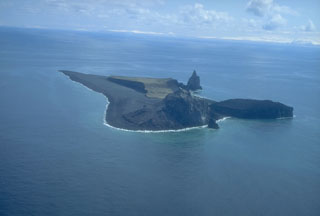Report on Bogoslof (United States) — 28 June-4 July 2017
Smithsonian Institution / US Geological Survey
Weekly Volcanic Activity Report, 28 June-4 July 2017
Managing Editor: Sally Sennert.
Please cite this report as:
Global Volcanism Program, 2017. Report on Bogoslof (United States) (Sennert, S, ed.). Weekly Volcanic Activity Report, 28 June-4 July 2017. Smithsonian Institution and US Geological Survey.
Bogoslof
United States
53.93°N, 168.03°W; summit elev. 150 m
All times are local (unless otherwise noted)
AVO reported that an explosion at Bogoslof was detected at 0124 on 30 June and lasted about 20 minutes. A small cloud from the event drifted about 16 km N and by 1815 had dissipated. Seismicity declined afterwards but continued intermittently at low levels. Beginning at 1248 on 2 July a significant explosive event was detected in seismic and infrasound data. The event lasted about 16 minutes, and produced an ash plume that rose as high as 11 km (36,000 ft) a.s.l. and drifted E. AVO raised the Aviation Color Code (ACC) to Red and the Volcano Alert Level (VAL) to Warning. Following the eruption seismicity declined and no signs of volcanic unrest were detected in seismic, infrasound, or satellite data on 3 July; the ACC was lowered to Orange and the VAL was lowered to Watch. The ACC and VAL were again raised to Red and Warning, respectively, following an explosive event that began at 1651 on 4 July and lasted 13 minutes. An eruption cloud rose as high as 8.5 km (28,000 ft) a.s.l. and drifted SE. An 11-minute-long eruption began at 1907 on 4 July, producing a small cloud that rose 9.8 km (32,000 ft) a.s.l. and drifted SE.
Geological Summary. Bogoslof is the emergent summit of a submarine volcano that lies 40 km N of the main Aleutian arc. It rises 1,500 m above the Bering Sea floor. Repeated construction and destruction of lava domes at different locations during historical time has greatly modified the appearance of this "Jack-in-the-Box" volcano and has introduced a confusing nomenclature applied during frequent visits by exploring expeditions. The present triangular-shaped, 0.75 x 2 km island consists of remnants of lava domes emplaced from 1796 to 1992. Castle Rock (Old Bogoslof) is a steep-sided pinnacle that is a remnant of a spine from the 1796 eruption. The small Fire Island (New Bogoslof), about 600 m NW of Bogoslof Island, is a remnant of a lava dome formed in 1883.
Source: US Geological Survey Alaska Volcano Observatory (AVO)

